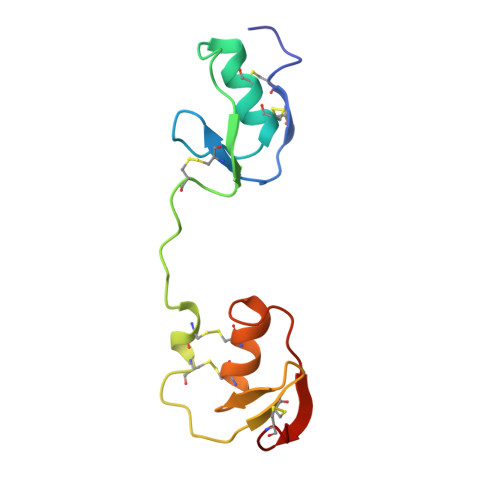Two heads are better than one: crystal structure of the insect derived double domain Kazal inhibitor rhodniin in complex with thrombin.
van de Locht, A., Lamba, D., Bauer, M., Huber, R., Friedrich, T., Kroger, B., Hoffken, W., Bode, W.(1995) EMBO J 14: 5149-5157
- PubMed: 7489704
- DOI: https://doi.org/10.1002/j.1460-2075.1995.tb00199.x
- Primary Citation of Related Structures:
1TBQ, 1TBR - PubMed Abstract:
Rhodniin is a highly specific inhibitor of thrombin isolated from the assassin bug Rhodnius prolixus. The 2.6 Angstrum crystal structure of the non-covalent complex between recombinant rhodniin and bovine alpha-thrombin reveals that the two Kazal-type domains of rhodniin bind to different sites of thrombin. The amino-terminal domain binds in a substrate-like manner to the narrow active-site cleft of thrombin; the imidazole group of the P1 His residue extends into the S1 pocket to form favourable hydrogen/ionic bonds with Asp189 at its bottom, and additionally with Glu192 at its entrance. The carboxy-terminal domain, whose distorted reactive-site loop cannot adopt the canonical conformation, docks to the fibrinogen recognition exosite via extensive electrostatic interactions. The rather acidic polypeptide linking the two domains is displaced from the thrombin surface, with none of its residues involved in direct salt bridges with thrombin. The tight (Ki = 2 x 10(-13) M) binding of rhodniin to thrombin is the result of the sum of steric and charge complementarity of the amino-terminal domain towards the active-site cleft, and of the electrostatic interactions between the carboxy-terminal domain and the exosite.
Organizational Affiliation:
Max-Planck-Institut für Biochemie, Abteilung Strukturforschung, Martinsried, Germany.
















